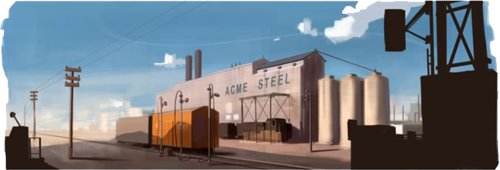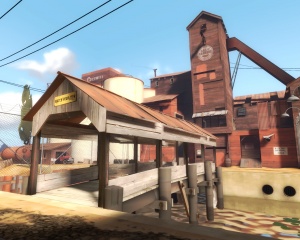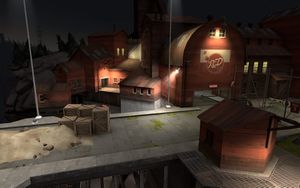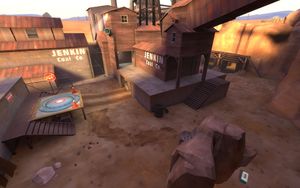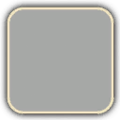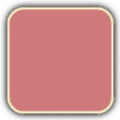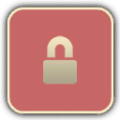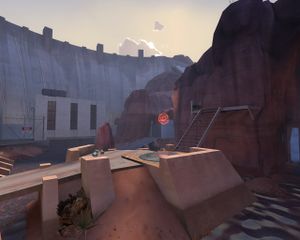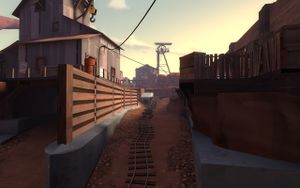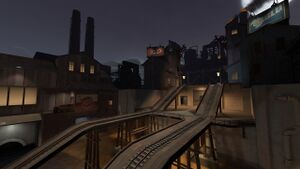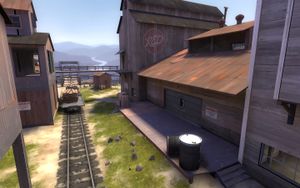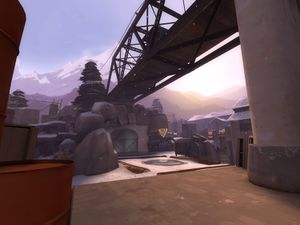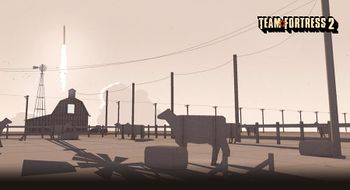Difference between revisions of "List of game modes/pl"
(→Kontrola terytorialna) |
m |
||
| Line 217: | Line 217: | ||
<references/> | <references/> | ||
| − | {{Maps nav | + | {{Maps nav}} |
[[Category:Lists/pl]] | [[Category:Lists/pl]] | ||
[[Category:Mapping/pl| ]] | [[Category:Mapping/pl| ]] | ||
[[Category:Game modes/pl| ]] | [[Category:Game modes/pl| ]] | ||
Revision as of 16:14, 12 October 2010
| Ta strona jest w trakcie tłumaczenia na język polski. Jeśli mówisz po polsku, napisz na stronie dyskusji lub porozmawiaj z użytkownikami, którzy wnieśli wkład do strony (sprawdź jej historię). |
Team Fortress 2 posiada aktualnie siedem trybów gry. Początkowo gra została wydana wraz z trzema z nich; późniejsze aktualizacje dodały cztery nowe tryby gry, jak np. Ładunek, Arena oraz Król wzgórza. Tryby gry są rozdzielone pomiędzy 39 oficjalnych map i operują sporą różnorodność stylów rozgrywki w Team Fortress 2.
Spis treści
Zdobądź flagę
| „ | Pomachajcie do swojego sekretnego badziewia, idioci!
Kliknij, by odtworzyć
— Skaut
|
” |
Tryb Zdobądź flagę obejmuje posiadanie przez zarówno RED, jak i BLU własnej teczki z tajnymi materiałami (znanej jako flaga). Celem obu drużyn jest przejmowanie tajnych materiałów wroga aż do przekroczenia ustalonego limitu gry (domyślnie 3), jednocześnie broniąc przed tym samym swoich tajnych dokumentów.
Tajne materiały obu drużyn są zazwyczaj rozmieszczone w najdalszej części ich baz, zazwyczaj w symetrycznych względem siebie lokacjach, w pomieszczeniu znanym jako "Pomieszczenie z tajnymi materiałami" (ang. Intelligence room). Aby przejąć tajne materiały wroga, należy ją najpierw dotknąć. Następnie trzeba zanieść ją do pomieszczenia z tajnymi dokumentami jego drużyny, gdzie należy wejść do swojej "strefy przejęcia" (oznaczonej żółto-czarnymi liniami) w celu udanego przejęcia. Po każdym udanym przejęciu drużyna jest nagradzana 10 sekundami obrażeń krytycznych.
Jeśli posiadacz tajnych materiałów zostanie zabity lub zostaną one celowo upuszczone, teczka będzie spoczywać w miejscu przez 60 sekund z widocznym odliczaniem nad teczką wskazującym, po jakim czasie tajne dokumenty wrócą do początkowego punktu. Podczas tego czasu tajne materiały mogą zostać ponownie podniesione w ten sam sposób, w jaki podnosi się je w bazie wroga. Czas powrotu dokumentów jest resetowany po każdym upuszczeniu. Przeciwnik nie może przemieścić lub zresetować położenia własnych materiałów. Tajne materiały nie mogą być przenoszone przez graczy z chwilową nieśmiertelnością (np. graczy pod działaniem ÜberCharge'a lub Skauci po wypiciu Bonk! Atomowego Kopa), tak samo gracze mający teczkę nie mogą jej uzyskać.
Jeśli posiadacz tajnych materiałów zginie w normalnie niedostępnej części mapy (np. wpadnie w dół), teczka natychmiast powraca do swojej początkowej lokalizacji. Jeśli żadna drużyna nie przekroczy limitu przejęć do upływu czasu, mecz wejdzie w tryb Nagłej śmierci.
W przeciwieństwie do wariantów trybu Zdobądź flagę w innych grach można dokonać przejęcia bez posiadania tajnych materiałów w swojej bazie.
Mapy typu Zdobądź flagę:
Punkty kontrolne
| „ | Ten punkt sam się nie przejmie! Ruszcie się!
Kliknij, by odtworzyć
— Inżynier
|
” |
Zobacz też: Punkty kontrolne
Mapy typu Punkty kontrolne posiadają dwa główne typy trybów gry.
Punkty kontrolne są okrągłymi platformami ze świecącą się w kolorze drużyny środkową częścią (neutralne punkty posiadają białe światło). Aby gracz przejąć punkt posiadany przez przeciwną drużynę, należy stać na punkcie do czasu, aż wskaźnik przejęcia wypełni się kolorem własnej drużyny. Im więcej ludzi z tej samej drużyny znajdzie się na punkcie, tym szybciej zostanie on przejęty, istnieje jednak pewien limit. Skauci oraz gracze noszący Pociąg Bólu liczą się jako 2 osoby przy przejmowaniu punktu. Punkt nie będzie przejmowany, jeżeli znajdują się na nim gracze z obu drużyn. Jeśli wszyscy przejmujący gracze zostaną zabici lub opuszczą punkt przed zakończeniem przejmowania, wskaźnik postępu przejmowania nie zresetuje się natychmiast, lecz będzie powoli się cofać.
Można wyróżnić trzy statusy punktu kontrolnego:
W grze znajdują się dwa główne rodzaje map typu Punkty kontrolne – standardowe Punkty kontrolne oraz mapy typu Atak/Obrona:
Standardowe punkty kontrolne
W mapy typu Standardowe punkty kontrolne gra się symetrycznie. Obie drużyny zaczynają z równą ilością punktów (po dwa punkty). Na mapie znajduje się też punkt środkowy, który nie jest kontrolowany przez nikogo. Wygrywa drużyna, która podbije wszystkie punkty kontrolne. Mapy typu Standardowe Punkty Kontrolne trwają do Nagłej Śmierci (lub Remisu), jeśli żadna z drużyn nie przejmie wszystkich punktów przed końcem czasu. Punkty kontrolne bliżej punktu odradzania są coraz szybciej zdobywane przez wroga.
Mapy typu Standardowe punkty kontrolne:
Atak/Obrona
W mapy typu Atak/Obrona gra się asymetrycznie. RED zaczynają z posiadaniem wszystkich punktów kontrolnych. BLU wygrają, jeśli podbiją wszystkie punkty wroga. Mogą być one podbite tylko w ustalonej kolejności (z wyjątkiem kilku map, takich jak Gravel Pit i Steel). RED wygrywają, jeśli powstrzymają BLU przed zdobyciem wszystkich punktów przed czasem. Punkty podbite przez BLU nie mogą wrócić w posiadanie RED.
Mapy typu Atak/Obrona mogą być w różnych stylach. Niektóre mapy, jak Dustbowl i Egypt wymagają od BLU, czyli atakujących, przechodzenia przez wiele etapów, zanim będą mogli ostatecznie zdobyć mapę. Jeśli atakującym nie uda się przejść każdego etapu, drużyny zamieniają się rolami i obrońcy będą atakującymi. Inne mapy, jak Gravel Pit i Junction, pozwalają atakującym podbić dwa punkty w przypadkowej kolejności (punkt A lub B) przed zdobyciem ostatniego punktu (punkt C). Steel jest unikalną mapą Atak/Obrona, w której to podbicie punktu podrzędnego (punktu A, B, C i D) dadzą lepszą dostępność punktu głównego (punkt E), np. odblokowanie nowych mostów i tras, aby inne klasy niż Skaut, Żołnierz, Demoman lub Inżynier mogli go zdobyć.
Mapy typu Atak/Obrona:
Kontrola terytorialna
| „ | Jesteście otoczeni, przynajmniej z tej strony!
Kliknij, by odtworzyć
— Żołnierz
|
” |
W Kontroli terytorialnej celem jest zajęcie całej mapy poprzez przejmowanie "terytoriów". Każda gra jest losowo wybierana spośród sześciu układów "punkt w punkt", gdzie drużyny muszą podbić punkt przeciwnika, a w tym czasie bronić swego własnego. Po pomyślnym przejęciu przeciwnego punktu następna runda następuje na innej arenie mapy, która jest również losowo generowana. Po przejęciu przez drużynę wszystkich czterech terytoriów wroga drużyna musi przejąć ich bazę, a drudzy bronić. Jeśli baza jest przejęta, atakujący wygrywają, obrońcy tracą najbliższy punkt od bazy (w Hydro Antena radarowa dla RED, Elektrownia dla BLU). Kiedy następuje kolejna runda, terytoria odnawiają się i następuje kolejna losowa gra.
W każdej grze TC jeśli punkt nie jest zajęty w ciągu 8 minut, gra zamienia się w Nagłą śmierć.
Mapy typu Kontrola Terytorialna:
Ładunek
| „ | Do przodu z tym wielkim wózkiem!
Kliknij, by odtworzyć
— Gruby
|
” |
In Payload maps, BLU team must escort a cart full of explosives through a series of checkpoints and into RED's base within a certain amount of time. BLU team members move or 'push' the cart by standing next to it - the more people nearby the cart, the faster it moves. Any RED team member standing near the cart will stop it from venturing further. If no BLU player pushes the cart after 30 seconds have passed, the cart will start moving backwards slowly until it reaches a checkpoint/BLU spawn or a BLU player stands next to it again. The cart works as a level 1 Dispenser for BLU team (and disguised enemy Spies) to restore health and ammunition to those pushing it.
Payload maps may or may not be split into multiple rounds. Some maps traditionally have one-way routes from the BLU side, sometimes closed off until a specific point is taken.
Some maps such as Gold Rush, Hoodoo and Thunder Mountain are split in three stages that BLU must advance through and win. Stages one and two have 2 checkpoints and stage three has 3 checkpoints (2 for Hoodoo) , counting the final point as such. Badwater Basin and Upward maps have a single round with 4 checkpoints, counting the final point as such. Advancing the cart to the next checkpoint gives the BLU team extra time. Advancing it to the final point moves the map onto the next stage. When the cart reaches the final point on the final stage, the Payload explodes and destroys RED base, symbolizing BLU's victory.
Payload maps:
Wyścig ładunków
Unlike standard Payload maps, Payload race maps feature both RED and BLU issued with a cart, thus teams are not defined to a attacking or defending role. To win, each team must simultaneously push their cart through enemy territory to reach the finishing point while preventing the enemy team from doing the same. As with Payload mode, team members push the cart by standing next to it, with more members increasing the speed of the cart and any opposing team member standing near the cart will stop it.
Unlike Payload mode, the cart will not move backwards after any duration of time and there is no time limit; the map will only end when one team successfully pushes their cart to the finish point. Each cart works as a Dispenser for their team (and disguised enemy Spies), restoring health and ammunition to those pushing the cart. Parts of the track may feature slopes, on which the cart will quickly roll back down to the bottom unless it is being constantly pushed.
Payload race maps may or may not be split into multiple rounds.
Payload race maps:
Arena
| „ | I say this to you with the unvarnished factualism of plain talk: I love Arena Mode.
— Abraham Lincoln, Second Inaugural Address, 1865
|
” |
Arena maps are designed to keep the class diversity of Team Fortress 2 while focusing goals around combat between two teams. Whereas other game modes lean towards a broad, overall strategy for the team, Arena concentrates on the specific tactical choices the teams make in a single fight. Arena maps carry the arena_prefix.
Arena features smaller maps that play out for shorter periods of time. The round ends once one team has no players left in the arena, or when the central capture point has unlocked and been captured. The central capture point unlocks after one minute has passed in the current round. Rounds tend to be very fast and highly competitive, with an emphasis on your team's class makeup and your plan to counter the opposing team's class choices. Arena mode is suitable for smaller matches of three vs. three players, while still comfortably supporting huge knockdown twelve-on-twelve brawls. Arena works much like Sudden Death - respawning is disabled and there are no resupply lockers. There are usually very few health kits available, often located far from the main action and/or near high-risk hazards. This forces teams to rely more on Dispensers and Medics.
Players may have to sit out to balance keep team numbers equal if they were on the losing team, but players on the winning team never have to sit out the next round.
The First Blood Critical buff is unique to the Arena game mode.
Arena maps:
Król wzgórza
| „ | Już od czasów ich odkrycia w 1895 r. wzgórza fascynowały królów.
— Bezklasowa Aktualizacja
|
” |
King of the Hill is similar to Arena. King of the Hill focuses on a single control point at the center of the map, which is unowned and locked at the beginning of the round. Teams must make their way to the Control Point and capture it when it becomes available. Once the point is captured by a team, their team clock will start a three minute countdown. If the enemy team manages to capture the point back, their clock will start counting down while the other team’s clock freezes at the time the point was recaptured. A team wins once they own the point and their three minutes is expired.
King of the Hill maps:
Trening
| „ | I make it look easy.
Kliknij, by odtworzyć
— Snajper
|
” |
Training maps are made specifically for teaching people the basics of gameplay and advanced techniques. Training mode shipped with the Mac Update, which introduced two official training maps.
Brandon Reinhart indirectly announced on the Official TF2 Blog on July 28, 2010 that Corey Peters is currently working on another official training map[1], though details are as of yet unknown for which class or what gameplay mechanics it focuses on.
Inne tryby gry
Highlander
| „ | Może być tylko jeden!
Kliknij, by odtworzyć
— Demoman
|
” |
Applicable to all existing game modes, Highlander mode restricts the number of players of each team to 9 players, and only allows one player per class on each team. It is applicable to any game mode, and can be activated by entering mp_highlander 1 into the console.
The idea behind Highlander mode existed previous to its official inclusion in the game, and has been implemented in server mods. Highlander mode was officially added in the February 3, 2010 Patch.
Niewydany
A new Gamemode was announced in the reveal of the Ploycount Pack winners, though not much is known about it at the time.
